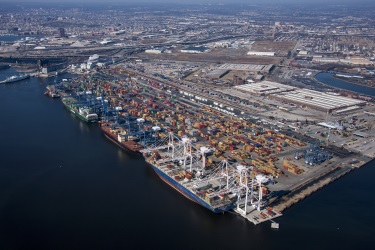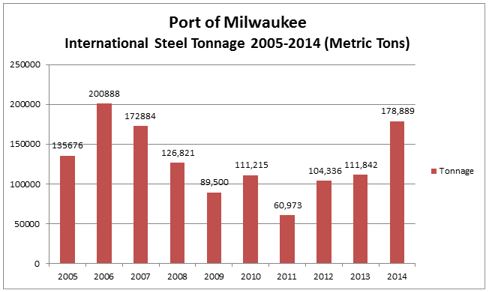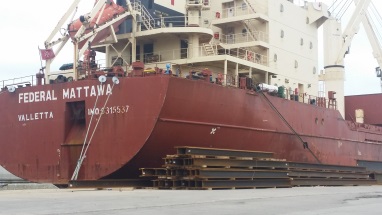
| December 23, 2014 | |
Cargo Trends: Alabama, Baltimore, Milwaukee, Saint John, Virginia
![]() Print this Article | Send to Colleague
Print this Article | Send to Colleague
Newly announced results show the Alabama State Port Authority earned record revenues of $162.3 million and handled a record 29.1 million tons of cargo through its terminals in the Port of Mobile during the fiscal year ending September 30, 2014. A record 46,827 containers moved through the Baltimore’s public marine terminals in October, beating the previous monthly record of 44,095 containers set in July 2013, according to data reported by the Maryland Port Administration (MPA). The Port of Milwaukee unloaded 179,000 metric tons of steel in 2014, the most in any year since 1970. November was yet another month of double-digit growth for Port Saint John’s booming container trade, with a 44.6 percent jump that the boosted year-to-date total to 83,955 TEUs and an increase from January-November 2013 of 20.9 percent. The Port of Virginia reports container volume reached 208,764 TEUs in November. That was up 8.2 percent from a year ago and gave the port its fifth consecutive month with a container count exceeding 200,000 TEUs.
Alabama State Port Authority Posts Second Straight Year of Record Revenues – Steel, Container and Coal Volumes UpNewly announced results show the Alabama State Port Authority earned record revenues of $162.3 million and handled a record 29.1 million tons of cargo through its terminals in the Port of Mobile during the fiscal year ending September 30, 2014.
The port authority says the record performance was primarily due to increased volumes of steel, export coal and containers. Its general cargo division ended the year with a record 7.3 million tons of iron, steel and forest products. Steel alone accounted for just over 5.0 million tons, a 40 percent increase compared to FY 2013.
The port authority’s bulk division handled 18.2 million tons of coal. Exports alone reached an all-time high of 13.7 million tons, thanks, the port authority says, "to increased demand globally for Alabama-mined metallurgical coal."
The port authority’s Terminal Railway handled 154,670 revenue rail cars through its switch and terminal yards, a nearly 4.0 percent increase.
During FY 2014 as well, volumes at the APM Terminals Mobile container facility increased 10 percent to 237,266 TEUs. Containerized cargos shipped through the Alabama seaport include automotive components, frozen poultry, forest products and consumer goods.
"The port authority’s investments in new facilities, post-Panamax cranes, and information technology, coupled with our excellent inland rail, highway and waterway connections, have helped expand the port authority’s business and afforded efficiencies to our customers," said Port Authority CEO Jimmy Lyons. "With continued investment in warehouses and intermodal rail, we believe the Port of Mobile will be well positioned to offer competitive service into new markets."
October 2014: A Record Month for Containers at the Port of BaltimoreA record 46,827 containers moved through Baltimore’s public marine terminals in October, beating the previous monthly record of 44,095 containers set in July 2013, according to data reported by the Maryland Port Administration (MPA).
"The Port of Baltimore is one of the most efficient seaports in the United States," said MPA Executive Director James J. White. "Our vessel production is among the highest for U.S. ports. Our new 50-foot deep container berth and four supersized cranes have placed us in a very competitive position to attract some of the largest ships in the world. The future of the Port of Baltimore has never looked brighter for the thousands of men and women who work on our marine terminals to support their families."
Throughput for the year through October was up 10.3 percent from the same time period in 2013, a record year for containers at the port’s public marine terminals.

Baltimore’s busy Seagirt
Marine Terminal.
Photo/Maryland Port
Administration
The Port of Milwaukee ended its second busiest steel cargo season on December 15 with the unloading of cargo from the Federal Mattawa. That brought this year’s steel volume to 179,000 metric tons, the most since 1970.
Steel is a raw material used in manufacturing in the Milwaukee region. So, an increase in steel moving through the port is a positive indicator of manufacturing activity.

Source/Port of Milwaukee
"Among the other factors affecting steel volumes at the Port of Milwaukee are global economic conditions, reliability and efficiency of delivering steel through the St. Lawrence Seaway, and cost-effective port operations in Milwaukee," said Acting Port Director Paul Vornholt. "Also, port tenant Federal Marine Terminals has been a valued partner in helping to increase steel tonnage."
Other cargoes this year included salt, cement, limestone, coal, grain and various manufactured products.
With the St. Lawrence Seaway due to close for the season late this month, the Federal Mattawa was the final ship to bring overseas cargo into the Port of Milwaukee. One additional ocean-going ship, the bulk carrier Three Rivers, left Milwaukee a few days later that week laden with soybeans for export to Turkey.Weather permitting, Laker vessels will continue to call Milwaukee on into the new year.

Federal Mattawa unloading
Milwaukee’s last inbound overseas cargo of the 2014 Seaway season.
Photo/Port of Milwaukee
November was yet another month of double-digit growth for Port Saint John’s booming container trade, with a 44.6 percent jump that boosted year-to-date total to 83,955 TEUs and an increase from January-November 2013 of 20.9 percent. This year’s growth follows the 60 percent jump the port experienced in 2013.
Similarly, containerized cargo during that same 11-month period rose 13.8 percent, from 458,940 to 522,463 metric tons.
The port’s prosperous dry bulk sector posted a year-to-date increase of 12.2 percent to 1,269,027 tons of potash, salt, recycled metals and petroleum coke.
"As a port community, our focus on increasing cargo at Port Saint John, particularly in the container sector, continues to mean greater economic activity for our city and province such as the 500 direct and indirect jobs attributable to movement of containerized cargo at this port," said Port Authority CEO Jim Quinn. "This container growth momentum is augmented by additional benefits being experienced in dry bulk at both Barrack Point Potash Terminal on the East Side and American Iron & Metal on the West Side. Diversity has always been a key to success at Port Saint John and this year is no exception."
Virginia: TEU Volumes Top 2.0 Million, Profits ContinueThe Port of Virginia reports container volume reached 208,764 TEUs in November. That was up 8.2 percent from a year ago and gave the port its fifth consecutive month with a container count exceeding 200,000 TEUs. Year-to-date volume totaled 2,189,764 TEUs, up 7.2 percent from 2,042,443 in January-November 2013.
In other calendar-year-to-date comparisons, the port reports volume increases from 2014 in containers handled by rail ( 3.6 percent), truck ( 8.7 percent), barge ( 16.0 percent) and via the Virginia Inland Port ( 13.9 percent). Details are provided by the attachment.
"Though we’re past peak season, we’re not seeing a significant let-up in our volumes," said John F. Reinhart, CEO and executive director of the Virginia Port Authority. "Thanks to the work of the Motor Carrier Task Force and candid input from stakeholders at the Port Productivity Summit, we are making some headway at the terminals to adapt to, and manage this kind of throughput. We still have a long way to go to reach the consistency in delivery of service that our customers and stakeholders seek."
The port finished November with operating income of $904,000, bringing the port’s string of consecutive profitable months to eight. Last November, the port posted an operating loss of $2.95 million.
"This is an improvement of $3.85 million versus the same month in 2013," Mr. Reinhart said. "Financially speaking we’re on the right path and we continue to seek improvement in some critical operational areas."
The port’s operating profit in the five months since the beginning of fiscal 2015 is $5.53 million, compared with an operating loss of $7.79 million in the same period of fiscal 2014, an improvement of $13.3 million. Moreover, the port has generated an operating profit in eight of the last nine months in calendar 2014.
The latest initiatives the port has undertaken to improve throughput include moving to a six-day workweek at Norfolk International Terminals (NIT) and Virginia International Gateway (VIG), relocation of the chassis yard and changes to the empty container receiving and dispatch process.
